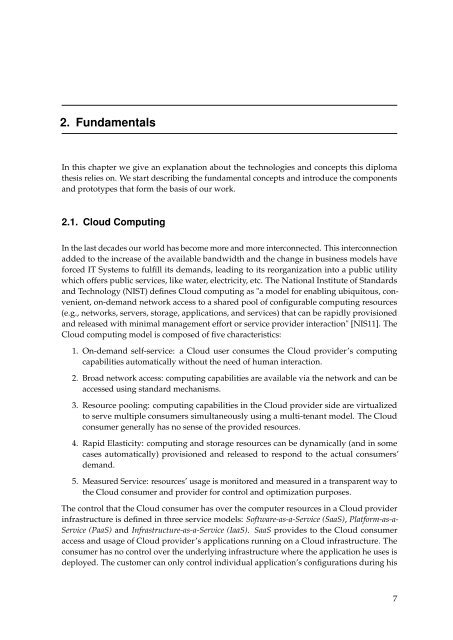Diploma Thesis Santiago Gómez Sáez - IAAS
Diploma Thesis Santiago Gómez Sáez - IAAS
Diploma Thesis Santiago Gómez Sáez - IAAS
You also want an ePaper? Increase the reach of your titles
YUMPU automatically turns print PDFs into web optimized ePapers that Google loves.
2. Fundamentals<br />
In this chapter we give an explanation about the technologies and concepts this diploma<br />
thesis relies on. We start describing the fundamental concepts and introduce the components<br />
and prototypes that form the basis of our work.<br />
2.1. Cloud Computing<br />
In the last decades our world has become more and more interconnected. This interconnection<br />
added to the increase of the available bandwidth and the change in business models have<br />
forced IT Systems to fulfill its demands, leading to its reorganization into a public utility<br />
which offers public services, like water, electricity, etc. The National Institute of Standards<br />
and Technology (NIST) defines Cloud computing as "a model for enabling ubiquitous, convenient,<br />
on-demand network access to a shared pool of configurable computing resources<br />
(e.g., networks, servers, storage, applications, and services) that can be rapidly provisioned<br />
and released with minimal management effort or service provider interaction" [NIS11]. The<br />
Cloud computing model is composed of five characteristics:<br />
1. On-demand self-service: a Cloud user consumes the Cloud provider’s computing<br />
capabilities automatically without the need of human interaction.<br />
2. Broad network access: computing capabilities are available via the network and can be<br />
accessed using standard mechanisms.<br />
3. Resource pooling: computing capabilities in the Cloud provider side are virtualized<br />
to serve multiple consumers simultaneously using a multi-tenant model. The Cloud<br />
consumer generally has no sense of the provided resources.<br />
4. Rapid Elasticity: computing and storage resources can be dynamically (and in some<br />
cases automatically) provisioned and released to respond to the actual consumers’<br />
demand.<br />
5. Measured Service: resources’ usage is monitored and measured in a transparent way to<br />
the Cloud consumer and provider for control and optimization purposes.<br />
The control that the Cloud consumer has over the computer resources in a Cloud provider<br />
infrastructure is defined in three service models: Software-as-a-Service (SaaS), Platform-as-a-<br />
Service (PaaS) and Infrastructure-as-a-Service (IaaS). SaaS provides to the Cloud consumer<br />
access and usage of Cloud provider’s applications running on a Cloud infrastructure. The<br />
consumer has no control over the underlying infrastructure where the application he uses is<br />
deployed. The customer can only control individual application’s configurations during his<br />
7

















